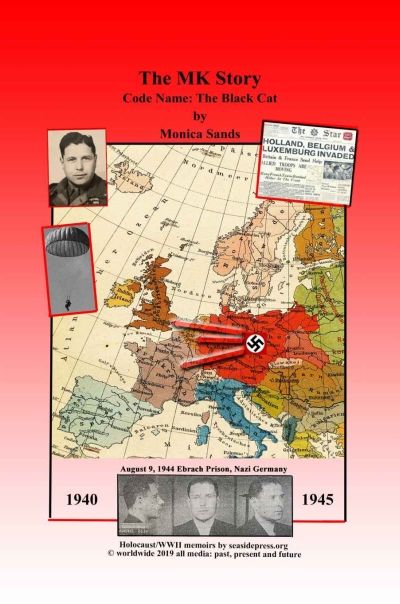| Title: | The MK story - Codename: The Black Cat |
| Writer: | Sands, M. |
| Published: | seasidepress.org |
| Published in: | 2019 |
| Pages: | 154 |
| Language: | English |
| ISBN: | 9781947940277 |
| Description: | There were only two Dutch Jewish secret agents active during the Second World War: Maurits Kiek (1909-1980) and Tom Biallosterski (1920-1945). Biallosterski was arrested and died in Scheveningen prison. Maurits Kiek survived the war, despite being sentenced to death by a German court for his resistance activities. In The MK Story his daughter, Monica Sands, tells his heroic story. Born and raised in The Hague, Maurits Kiek had two sisters. He was a calm child who was not a fan of sports or other outdoor activities. He had a knack for languages and spoke excellent German, English and French. He also had a fascination for electronics and mechanics; locks, watches and radios were among the items he cherished. After obtaining an amateur radio licence, Kiek started working for a radio manufacturer and learnt Morse code. He had wanted to become a pilot in the pre-war Dutch army, but was unable to due to his colour blindness. Once it was discovered that he also had flat feet, his military career was over. Undeterred, he took private flying lessons and obtained the coveted pilot's licence. He then came into contact with the Ghent Chief of Police and a British major. Kiek regularly took the major on reconnaissance flights over the border area of Belgium, the Netherlands and Germany, during which aerial photographs were taken. On these flights, Maurits' color blindness proved unexpectedly useful, as it meant he was particularly good at estimating depth, and could clearly see shapes and lines on the ground. He discovered cunningly camouflaged German tank positions near the borders of the border triangle. In short, Maurits was well suited for intelligence work. Later, Maurits was asked to go to Aachen to assist in the escape of a Jewish man wanted by the Nazis. He continued to observe German military and tactical activities until the outbreak of the war, reporting back to British intelligence. In May 1940, the German invasion of the Netherlands and Belgium began. Maurits, with the help of contacts in the Belgian resistance, helped people who were seen as enemies of the Reich to escape and taught members of the resistance how to maintain illegal radio contact with England. For these activities, the Dutchman was placed on a German wanted list. The German Abwehr was so keen to get his hands on him that a large bounty was put on his head, dead or alive. Having decided to escape, the resistance fighter managed to reach England after a long journey. The Dutch authorities did not want to send him back into occupied territory as a secret agent (a Jew who volunteered to return to Nazi occupied territory was considered a madman or a traitor). Maurits was instead recruited by the British Intelligence Service MI9. After training, he was dropped into France in July 1943, afterwards setting up an escape organisation in Belgium and communications between the Dutch and Belgian organisations. He also set up a radio link with England. With his cooperation, thirty-two downed Allied pilots were smuggled to England. Maurits was arrested in Brussels in September 1943, only a few days before he was due to return to the United Kingdom. In May 1944 he was sentenced to death by the court of the German Luftwaffe in Brussels. However, he was not immediately executed but instead deported to Germany. There, he was interned in various concentration camps and prisons until he was liberated by the US Army in April 1945. The importance of the Maurits Kiek's work is clear from the number of countries that have honoured him. The Netherlands awarded him, among other distinctions, the Bronze Cross, the United States the Medal of Freedom, Belgium, among other distinctions, the Belgian Order of Leopold and the King's Medal for Courage in the Cause of Freedom. Both his Jewish heritage and the fact that Maurits was already contributing to the British war effort before the outbreak of war in the Netherlands make this a fascinating story. It was not easy for his daughter to research her father's war career: many files about him remain secret and inaccessible. The self-published book (available from Amazon) is written in accessible language and includes photos and illustrations that bring the story to life. Thanks to this beautifully written book, this relatively unknown war hero will get the credit he deserves. |
| Rating: |     Very good Very good |
Information
- Translated by:
- Tomas Brogan
- Article by:
- Wijnand de Gelder
- Published on:
- 18-07-2021
- Last edit on:
- 31-01-2022
- Feedback?
- Send it!



